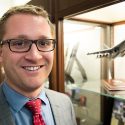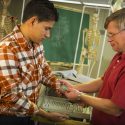Campus diversity efforts to focus on achievement gap, shared definition
As he heads into his third year on the job as vice provost for diversity and climate, Damon Williams is putting into place what he’s learned about UW–Madison since taking his post. One of the first steps was bringing a range of diversity programs from across campus together in his office, a reorganization that happened this summer.

Williams
Ahead of the Sept. 30 diversity forum (see sidebar), Williams discussed with Wisconsin Week the future of diversity efforts on campus.
Wisconsin Week: Can you talk about the reorganization of diversity programs on campus and what that means?
Williams: We spent a good amount of time taking a look across the country, identifying what some of our national peers were doing with respect to this work. One of the recommendations was to move some of our most prominent diversity efforts directly in strategic alignment with my office such that I could play a much more direct, hands-on role in assuring that they’re pointed towards the goals that we’re focused on institutionally.
WW: What’s your vision for the upcoming school year?
DW: First, we’re going to create a very clear sense of what some initial deliverables or outcomes are that we’d like to get done in terms of this divisional work. Second, we’ll be working closely with Vice Provost for Faculty and Staff Steve Stern in launching our more aggressive faculty diversification effort.
The third thing that we’ll be working on campuswide is we really want to become more prominent in our communication around the diversity work that’s happening across campus.
Finally, we’re also working very proactively with campus partners across the board around our continuing challenges in terms of our six-year graduation rates for historically underrepresented students.
WW: Bridging the achievement gap has been a central goal. What progress can you talk about there?
DW: We’re trying to get laser-like clarity from a data perspective about where the challenges are. We have a sense of where students are having the most academic difficulty. But we want to clarify why, what the difficulty really is and what’s causing it…and what are some of the experiences that matter the most to student success.
What’s emerged from some of that fact-finding is the importance of the involvement of students in first-year interest groups, learning communities, undergraduate research experiences and one-to-one mentorship relationships with faculty members. These programs benefit all students, but they have an even more dramatic and positive benefit toward historically underrepresented students.
One of the things (the Letters & Science Equity and Diversity Committee) uncovered in their research is they looked at courses where students had the greatest adverse outcomes, the greatest grade differentials. In those courses, they actually did surveys of campus climate.
What we’ve begun to understand is there’s something about this experience that is not working in a way that maximally benefits all of our students. How can we partner with faculty in finding solutions? How do we empower students to understand how to navigate the dynamics when they experience them?
WW: What challenges do the demographics of Wisconsin present in attracting and retaining a diverse student population?
DW: Like many states, Wisconsin has pipeline issues. For example, for every 100 minority students who graduate from high school in our state, only 46 take the ACT. Only six of the 100 are what we would consider “well-prepared academically,” meaning that they scored at least 22 on the ACT and were ranked in the top quartile of their class. Five of 100 will apply for admission here, four will be admitted and three will enroll.
We also face challenges in terms of recruiting first-generation and low-income students. The percentage of UW–Madison new freshmen in these groups is less than the percentage in the overall population of high school graduates. In fall 2009, 16 percent of new freshmen were from low-income families, and 23 percent were first-generation college students.
Building a better pipeline is something that we have been committed to as an institution for a long time, both with our longstanding investment in the PEOPLE program and more recently with the Posse program. In addition, we are making great strides with making attendance here more affordable for our most economically vulnerable students through the Madison Initiative for Undergraduates and the Great People Scholarship Campaign.
WW: What advantages does a diverse population deliver to all UW–Madison students, faculty and staff?
DW: There is a growing realization nationwide that as our demographics continue to change, and as our workplaces become increasingly global, that our graduates need to be prepared to interact with people from a broad range of backgrounds. They need to be able to interact productively with people who are different culturally, economically and in terms of nation of origin.
In addition, a diverse university community helps to ensure that our students’ learning experiences are intellectually rich, both in the classroom and in the broad range of learning opportunities that happen outside of class. This is happening not only through our programs for underrepresented minorities, but also through things like the Chinese Champions Program that Chancellor Martin piloted this year and our world-class study abroad program.
WW: What is the pipeline doing to deliver students from underrepresented groups to UW–Madison, and how are they performing?
DW: We have a number of programs that have developed to improve our pipeline in terms of both racial/cultural and economic diversity, and we are seeing some successes there. For instance, between 2001 and 2009, our freshman-targeted minority enrollments increased from 389 to 630. Some of our programs have produced very impressive results. Over the last five years, our minority six-year graduation rate has risen from 55 percent to 66 percent. Students in the Chancellor’s Scholars program have exhibited higher retention and graduation rates than the overall student population. And the First Wave program, which will graduate students from its first cohort this year, has nearly a 100 percent retention rate.
That’s not to say that we don’t still have a considerable amount of work to do. Campuswide, overall minority graduation and retention rates still lag behind our overall rates. And many of our students of color, particularly those who do not participate in one of our academic excellence or high-impact learning programs, feel isolated on our campus. We’re encouraged by the advances that we’ve made so far, and we’re looking forward to even more progress as we continue to be more strategic in how we address these challenges.
WW: The theme for last year’s diversity forum was “Seeding Inclusive Excellence” — where is that idea of inclusive excellence right now and how is that taking shape?
DW: We’ve got to be thinking about diversity in broad terms when we’re talking about diversity at a university of our preeminence and magnitude. We’ve got to be critically focused on historic issues of access and equity for underrepresented groups. As we define diversity we need to be broadly inclusive of a number of different backgrounds and identities.
Another thing about our Inclusive Excellence agenda moving forward is we think that we’ve got to point ourselves to even higher standards of accountability around this work. We’ve got to continue to find ways to push the impossible and move ourselves out of comfort zones. I want to help us find that space of an even higher level of expectation, support and accountability to be sure we’re absolutely getting the most out of what we’re investing in this area.
I think that if we’re going to become the nation’s most preeminent institution around these issues, then accountability’s got to be a huge process in that. My view of accountability is it has to be something we agree upon as a community. It’s got to be shared and it’s got to be agreed upon by our highest levels of governance and shared leadership.
WW: Can you talk more about the diversity Web site you’re creating and what it might look like?
DW: We are working with UW Communications and DoIT to create a Web site that will be even more of a pathway into other lenses of diversity. We intend for it to be more dynamic than our current diversity Web site in terms of having blogs and guest voices and more multimedia possibilities. It will also become a departure point for individuals to link with our Facebook page and become members of our Twitter community.
WW: One other thing coming up in the spring is that the first class of First Wave students is expected to graduate this year. What is the significance of that milestone and what does that mean for other diversity efforts that you’re working on?
DW: First Wave is probably one of the most exciting things that we’re doing in terms of undergraduate education in the entirety of the university. It’s one of the most exciting, cutting-edge and fresh efforts that’s happening anywhere around the country, indeed the world, in terms of working with youth at the intersection of the arts, academic excellence, urban reality and issues of identity, and hip-hop culture.



